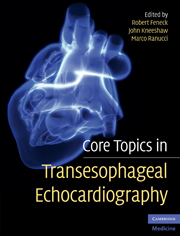Crossref Citations
This Book has been
cited by the following publications. This list is generated based on data provided by Crossref.
Hall, Roger M. O.
2012.
Core Topics in Cardiac Anesthesia.
p.
147.
2012.
Core Topics in Cardiac Anesthesia.
p.
133.
Silva, Luis A. Bastiao
Campos, Samuel
Costa, Carlos
and
Oliveira, Jose Luis
2013.
Integrating echocardiogram reports with medical imaging.
p.
373.
Silva, Luís A. Bastião
Campos, Samuel
Costa, Carlos
and
Oliveira, José Luis
2014.
Sensor-Based Architecture for Medical Imaging Workflow Analysis.
Journal of Medical Systems,
Vol. 38,
Issue. 8,
Fatin Inani binti Nurullail
Pahl, Christina
and
Supriyanto, Eko
2015.
Image based Transesophageal Echocardiography probe tip localization.
p.
169.
Jafar, Nadia
Moses, Michael J.
Benenstein, Ricardo J.
Vainrib, Alan F.
Slater, James N.
Tran, Henry A.
Donnino, Robert
Williams, Mathew R.
and
Saric, Muhamed
2017.
3D transesophageal echocardiography and radiography of mitral valve prostheses and repairs.
Echocardiography,
Vol. 34,
Issue. 11,
p.
1687.
Swanevelder, Justiaan
and
Roscoe, Andrew
2020.
Core Topics in Cardiac Anaesthesia.
p.
239.
Park, Hyun-Tae
and
Um, Ji-Yong
2021.
Image-Free Ultrasound Blood-Flow Monitoring Circuit System with Automatic Range-Gate Positioning Scheme: A Pilot Study.
Applied Sciences,
Vol. 11,
Issue. 22,
p.
10617.
Morany, Adi
Lavon, Karin
Bluestein, Danny
Hamdan, Ashraf
and
Haj-Ali, Rami
2021.
Structural Responses of Integrated Parametric Aortic Valve in an Electro-Mechanical Full Heart Model.
Annals of Biomedical Engineering,
Vol. 49,
Issue. 1,
p.
441.



